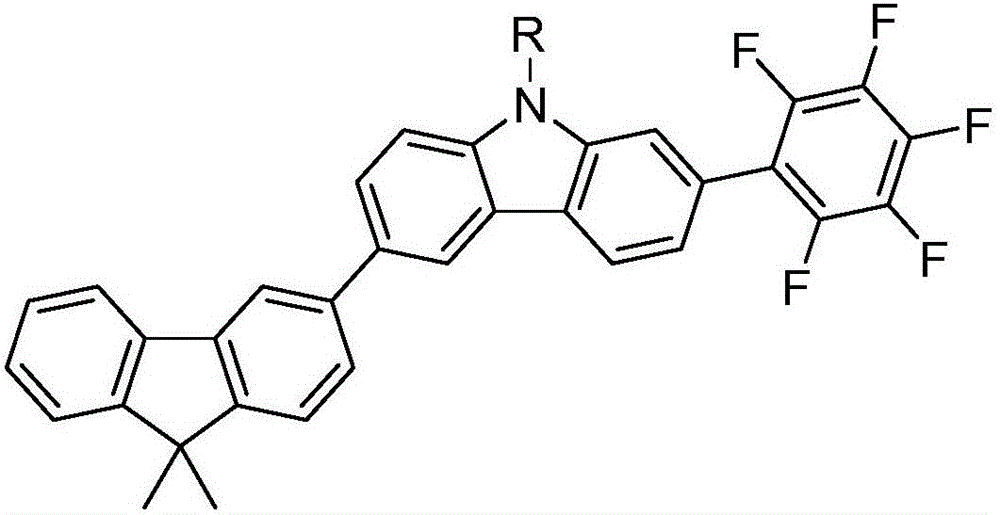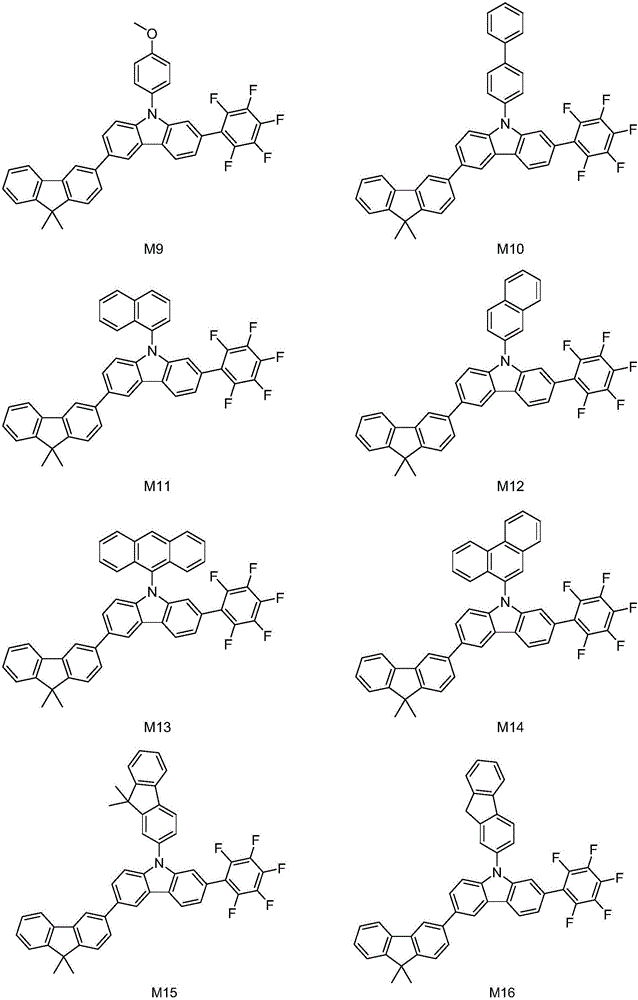Organic electroluminescence material and preparation method and application thereof
An electroluminescent material and electroluminescent technology, which are applied in the fields of luminescent materials, organic chemistry, chemical instruments and methods, etc., can solve the problems of increased device manufacturing cost, and achieve the advantages of simple preparation method, improved luminous efficiency, and excellent electron transport ability. Effect
- Summary
- Abstract
- Description
- Claims
- Application Information
AI Technical Summary
Problems solved by technology
Method used
Image
Examples
preparation example Construction
[0039] The present invention also provides a method for preparing an organic electroluminescence material, comprising:
[0040] Under the protection of argon, the compound shown in Formula A is subjected to a coupling reaction to obtain the organic electroluminescent material of the present invention:
[0041]
[0042] The selection of the R group is the same as above, and will not be repeated here.
[0043] According to the intermediate A of the present invention, it is prepared according to the following method:
[0044] (1) Take 100mmol iii and add iv 50mmol, 2M K 2 CO 3 Solution 150ml, solvent THF 600ml, tetrakistriphenylphosphopalladium 1mmol, Ar gas replacement three times, reflux reaction for 6h, to obtain the product.
[0045] (2) Take 40mmol of the product from the previous step and add v 40mmol, 2M K 2 CO 3 Solution 60ml, solvent THF 300ml, tetrakistriphenylphosphopalladium 0.4mmol, Ar gas replacement three times, reflux reaction for 6h, to obtain the product...
Embodiment 1
[0057] Embodiment 1: the preparation of intermediate A
[0058] (1) Take 100mmol iii and add iv 50mmol, 2M K 2 CO 3 Solution 150ml, solvent THF 600ml, tetrakistriphenylphosphopalladium 1mmol, Ar gas replacement three times, reflux reaction for 6h, and recrystallization to obtain 42mmol of the product.
[0059] (2) Take 40mmol of the product from the previous step and add v 40mmol, 2M K 2 CO 3 Solution 60ml, solvent THF 300ml, tetrakistriphenylphosphopalladium 0.4mmol, Ar gas replacement three times, reflux reaction for 6h, to obtain the product 31mmol.
[0060] (3) Take 30 mmol of the product from the previous step, add 150 mmol of triethyl phosphite, 100 ml of o-dichlorobenzene as a solvent, and react under reflux for 24 hours to obtain 21 mmol of product vi.
[0061] (4) Take 20mmol of the product vi from the previous step, add 18mmol of NBS, and 100ml of dichloromethane as a solvent, and react at room temperature for 10h to obtain 14mmol of product i.
[0062] (5) Take...
Embodiment 2
[0066] Embodiment 2: the synthesis of compound M1:
[0067]
[0068] Take 10mmol of intermediate A, add 10mmol of iodoethane, solvent toluene, potassium tert-butoxide 30mmol, Pd2(dba) 30.2mmol, replace with Ar gas three times, add 0.8mmol of tri-tert-butylphosphine, and replace with Ar again three times. The temperature was raised to reflux for 8h. The crude product was passed through a silica gel column to obtain 7 mmol of the product with a yield of 85%. Mass Spectrum m / z: 553.18 (calculated: 553.17). Theoretical element content (%)C 35 h 24 f 5 N: C, 75.94; H, 4.37; F, 17.16; N, 2.53; Measured element content (%): C, 75.84; H, 4.47; F, 17.08; N, 2.61. The above results confirmed that the obtained product was the target product.
PUM
 Login to View More
Login to View More Abstract
Description
Claims
Application Information
 Login to View More
Login to View More - R&D Engineer
- R&D Manager
- IP Professional
- Industry Leading Data Capabilities
- Powerful AI technology
- Patent DNA Extraction
Browse by: Latest US Patents, China's latest patents, Technical Efficacy Thesaurus, Application Domain, Technology Topic, Popular Technical Reports.
© 2024 PatSnap. All rights reserved.Legal|Privacy policy|Modern Slavery Act Transparency Statement|Sitemap|About US| Contact US: help@patsnap.com










